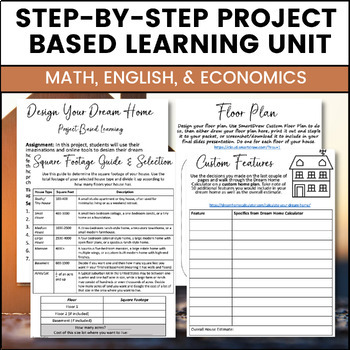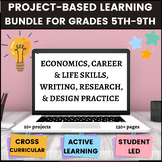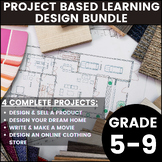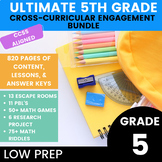Design Your Dream Home - Middle & High School Project Based Learning Unit PBL
- PDF
Also included in
- These are great for summer school, home school, genius hour, enrichment, gifted, or independent work time!A growing bundle of my Project Based Learning Units!Currently Includes:Run a Bake SaleDesign & Sell a ProductPlan a Trip to Travel AbroadDesign Your Dream HomePlan a PartyPlan a Music FestivPrice $55.00Original Price $66.00Save $11.00
- These are great for summer school, home school, genius hour, enrichment, gifted, or independent work time!Encourage Creativity and learning with this Design Based Product Based Learning Bundle! Currently Includes 4 Engaging Units:Design & Sell a ProductDesign Your Dream HomeWrite & Make a MoPrice $20.00Original Price $24.00Save $4.00
- This incredible bundle includes exciting, unique, and engaging resources for student-led, project-based, partner-focused instruction, this bundle is perfect for teaching a wide range of subjects in an interactive and fun way.13 Math Escape Rooms - with each covering two to three 5th Grade CCSS11 CroPrice $145.00Original Price $218.00Save $73.00
Description
In this project, students will use their imaginations and online tools to design their dream home. They will research lot price, learn about square feet, decide on their preferred house size and features, then draw or make a slideshow of what their dream home would look like. They will present their final product with concise details and reasoning for their choices.
In-depth Description:
In this Design Your Dream Home project, students will have the opportunity to unleash their creativity and develop critical thinking and teamwork skills. This project-based learning activity is designed for students in grades 5-8 and can be implemented in various settings such as summer school, homeschool, genius hour, enrichment, or independent work time.
The packet includes all the necessary information and guidance for the project, along with online resources. The project is divided into several sections including square footage guide and selection, selection notes, custom features, floor plan, and presentation.
Benefits:
- Develop critical thinking and problem-solving skills
- Foster creativity and imagination
- Enhance communication and collaboration skills
- Apply real-life application and career readiness skills
- Engage students in a fun and meaningful project-based learning experience
Instructions/Tips for Implementation:
- Provide students with the packet and review the instructions and guidelines.
- Explain the timeline and allocate sufficient time for each section of the project.
- Encourage students to conduct research and use online resources to enhance their designs.
- Facilitate teamwork and collaboration by allowing students to work in pairs or small groups.
- Provide opportunities for students to showcase their final presentations to the class or an audience.
- Use the included presentation rubric to assess student work and provide feedback.
Related Products:






